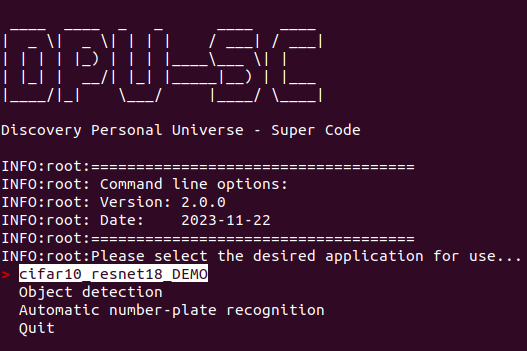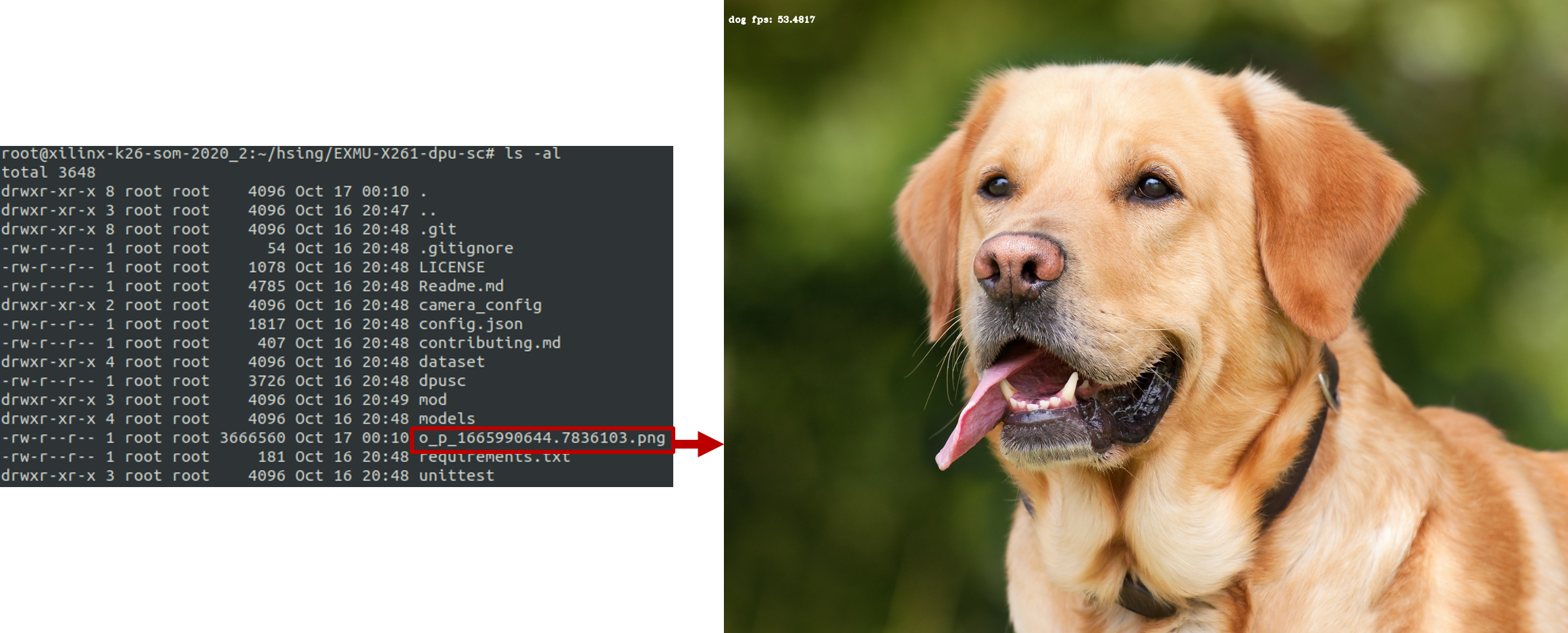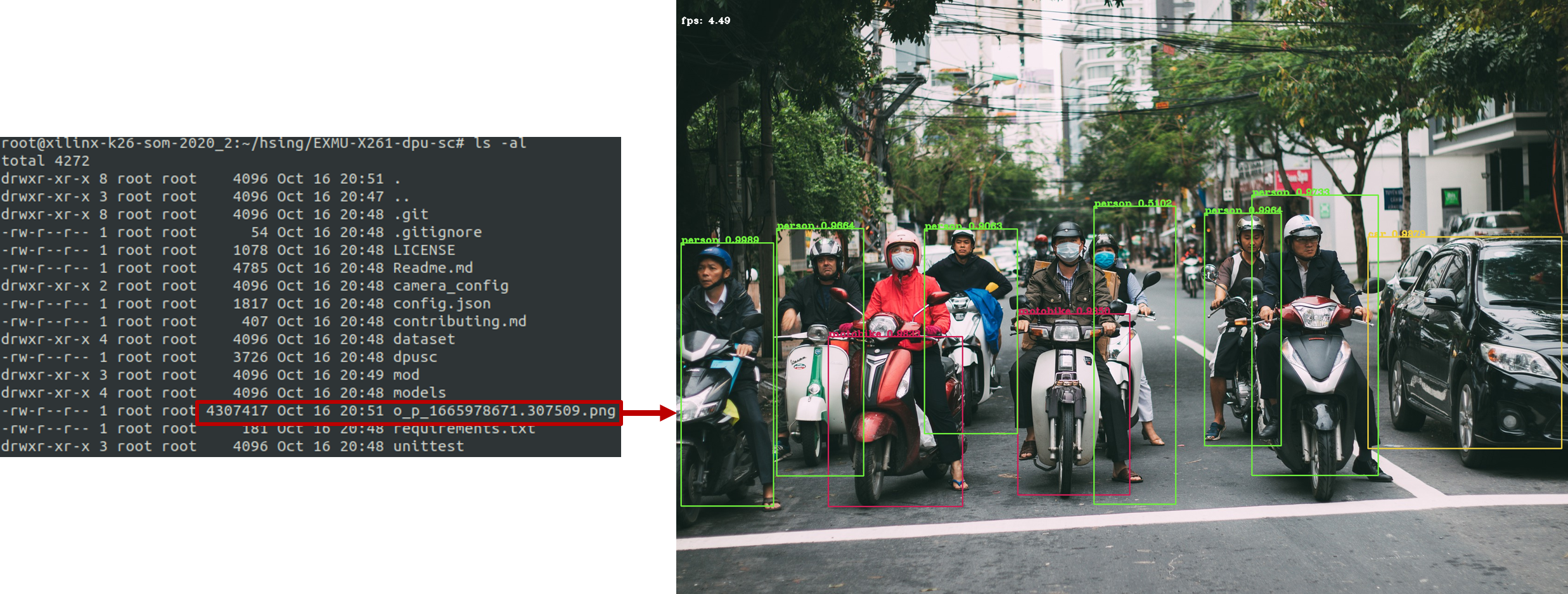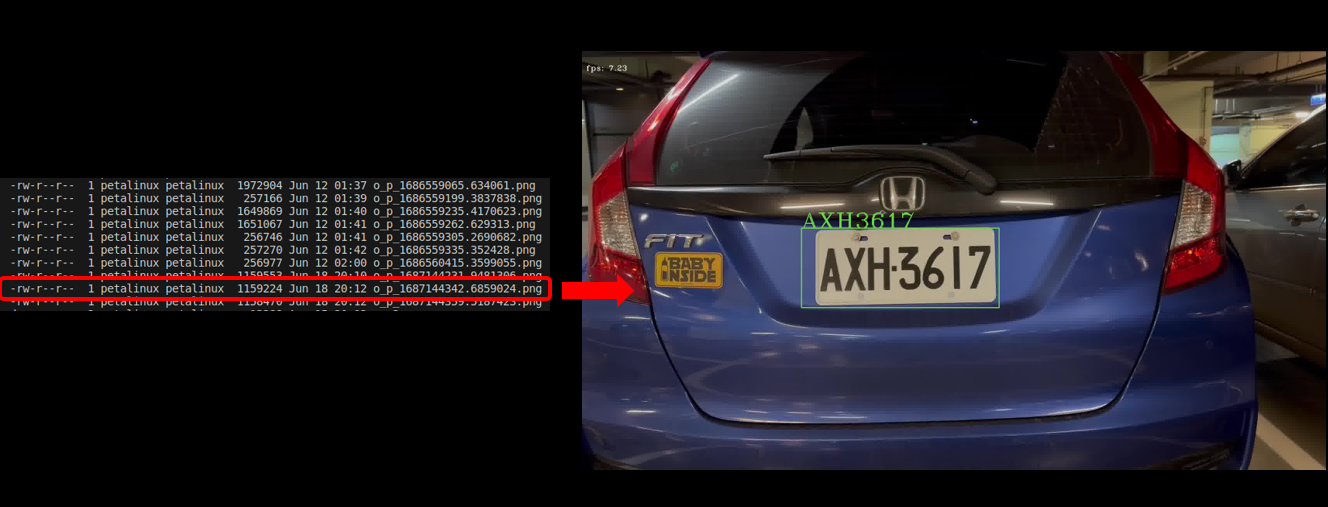dpu-sc presented a rapid demo which run AI inference on DPU with MPSoC.
sudo python3 -m pip install --upgrade pip
sudo python3 -m pip install scikit-build cmake opencv-python mock cython
sudo python3 -m pip install tensorflow==2.4.1 -f https://tf.kmtea.eu/whl/stable.htmlWe provide three modes for AI sample:
- Cifar10 Resnet18 DEMO: Default Resnet18 model. For inference Resnet18 by Cifar10 dataset
- Object detection: Default YOLO model. For inference some common objects.
- Automatic number-plate recognition(ANPR): We supported Taiwain plate license detection and recognition.
Notice: Our models were built for DPU3136, if you want to use DPU4096 or others DPU config, please contact our PM James(james_chen@innodisk.com). Also, we supported Vitis-AI 2.5 now.
Note: The CNNs in the old version of DPUSC are no longer supported after BSP version 1.2.2(Vitis-AI 2.5).
To use this program, first clone the repo. Then, run the following code in a terminal window. The program will launch in the window.
# Start to run code
python3 dpusc As you can see, the code has successfully executed. Here is a screenshot of the output.
To select the application you want to use, you will be presented with a list of options.
Next, select your input source.
Next, enter the location of your input source.
Finally, select the format to save the output results in. The output format must be the same as the input format, except for DP.
Now only support IMAGE mode
After selecting the first application "Cifar10_Resnet18_DEMO" and choosing the input and output formats, you will get the following results and find the output file in the folder.
After selecting the second application "Object detection" and choosing the input and output formats, you will get the following results and find the output file in the folder in the format you selected.
Additionally, during inference, you can view inference information, including bounding boxes and FPS, in the terminal window.
After selecting the third application "Automatic number-plate recognition" and choosing the input and output formats, you will get the following results and find the output file in the folder in the format you selected.
Additionally, during inference, you can view inference information, including bounding boxes, FPS, and license plate detection results, in the terminal window.
Previously, users had to manually modify the config.json file to switch applications. However, in this version update, we have integrated config.json directly into DPUSC. This will significantly reduce the learning curve for beginners.
But, if you want to try to modify the JSON content, you can still find relevant annotations in the table below.
-
DISPLAY
"DISPLAY": { "WIDTH": "1920", "HEIGHT": "1080", "DISPLAY_CARD_PATH": "/dev/dri/by-path/platform-fd4a0000.zynqmp-display-card" }
Key Name Description WIDTHThe width of your display resolution. HEIGHTThe height of your display resolution. DISPLAY_CARD_PATHThe path of your display card location. -
MODLES-XMODELS_CLASS
"MODLES": { "XMODELS_CLASS": { "TYPE": "cnn", "MODEL": "models/cnn/customcnn.xmodel", "CLASS": ["dog", "cat"], "INPUT_SIZE": [250, 200] } }
Key Name Description TYPEXmodel's type. MODELPath to xmodel. CLASSThe classes that the xmodel provide. INPUT_SIZEThe image size that the xmodel can accept. -
MODLES-XMODELS_OBJ
"MODLES": { "XMODELS_OBJ": { "TYPE": "yolo", "MODEL": "models/obj/yolov3-voc.xmodel", "CLASS": ["aeroplane", "bicycle", "bird", "boat", "bottle", "bus", "car", "cat", "chair", "cow", "diningtable", "dog", "horse", "motobike", "person", "pottedplant", "sheep", "sofa", "train", "tv"], "ANCHORS": [ 10, 13, 16, 30, 33, 23, 30, 61, 62, 45, 59, 119, 116, 90, 156, 198, 373, 326], "INPUT_SIZE": [416, 416], "IOU": "0.213", "NMS": "0.45", "CONF": "0.2", "BOX_MAX_NUM": "30" } }
Key Name Description TYPEXmodel's type. MODELPath to xmodel. CLASSThe classes that the xmodel provide. ANCHORSThe anchors that the xmodel provide. INPUT_SIZEThe image size that the xmodel can accept. IOUXmodel's IoU(Intersection over Union). NMSXmodel's NMS(Non-Maximum Suppression). CONFXmodel's confidence. BOX_MAX_NUMThe maximum number of bounding box that can be displayed in an image. -
MODLES-XMODELS_LPR
"XMODELS_LPR": { "TYPE": "lpr", "MODEL": "models/lpr/LPR_kv260.xmodel" }
Key Name Description TYPEXmodel's type. MODELPath to xmodel. -
OUTPUT
"OUTPUT": { "VIDEO_OUTPUT": "./output.mp4", "IMAGE_OUT_DIR": "./" }
Key Name Description VIDEO_OUTPUTThe path of the output video. IMAGE_OUT_DIRThe path of the output image directory.
provide unittest script in /unittest.
In this unit, you can test whether there are any projects that fail to run due to hardware problems.
./unittest.sh [TEST]
[TEST]
dpu: run the dpu unit test
util: run the utility unit test
yolo: run the yolo unit test
all: run all off the dpu unit testYou can use following setps to download and install tensorflow or use our RPM package to install (please contact james_chen@innodisk.com).
-
Use following command to download the
tensorflow.whl.sudo wget https://github.com/KumaTea/tensorflow-aarch64/releases/download/v2.4/tensorflow-2.4.1-cp37-cp37m-linux_aarch64.whlIf the python version is 3.9.x. Please download by following command.
sudo wget https://github.com/KumaTea/tensorflow-aarch64/releases/download/v2.4/tensorflow-2.4.1-cp39-cp39-linux_aarch64.whl -
Install the
tensorflow.whlwithout any dependencies.sudo pip3 install --no-dependencies tensorflow-2.4.1-cp37-cp37m-linux_aarch64.whlIf the python version is 3.9.x. Please install by following command.
sudo pip3 install --no-dependencies tensorflow-2.4.1-cp39-cp39-linux_aarch64.whl -
After install
tensorflow, follow the instructions below to manually install dependencies which we need.- Create a file named
requirements.txt. - Fill the following dependencies in requirements.txt.
Keras-Preprocessing==1.1.2 flatbuffers==22.12.6 termcolor==2.1.1 astunparse==1.6.3 gast==0.5.3 opt-einsum==3.3.0 typing-extensions==4.4.0 wrapt==1.14.1 google-api-python-client==2.70.0 absl-py==1.3.0 - Use the following command to install the dependencies
python3 -m pip install -r requirements.txt
- Create a file named
-
Now you can run the dpu-sc with tensorflow.









